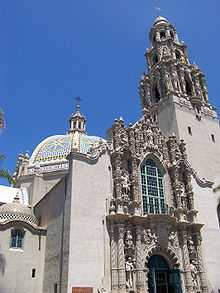San Diego Natural History Museum
Coordinates: 32°43′55.6″N 117°8′50.29″W / 32.732111°N 117.1473028°W
The San Diego Natural History Museum is a museum located in Balboa Park in San Diego, California. It was founded in 1874 as the San Diego Society of Natural History. It is the third oldest scientific institution west of the Mississippi and the oldest in Southern California. The present location of the museum was dedicated on January 14, 1933.[1] A major addition to the museum was dedicated in April 2001, doubling exhibit space.
History
First fifty years
.jpg)
Founded in 1874, the San Diego Society of Natural History is the oldest scientific institution in southern California, and the third oldest west of the Mississippi. In its initial years, the Society was the region's primary source of scientific culture, serving a small but growing community eager for information about its natural resources. Early society members established a weather station, petitioned to create Torrey Pines State Reserve, and garnered support for the San Diego Zoological Society.
In June 1912, the Society met for the first time in its new quarters in the Hotel Cecil, recently built on 6th Avenue in San Diego. Later that same month exhibits created by Frank and Kate Stephens were installed in a single room and adjoining alcove, and were open to the public several afternoons each week. The Society had opened its first museum.
In 1917, the Society purchased a vacant Balboa Park building from the 1915 Panama-California Exposition. Here the Society moved its growing collections and library to create the San Diego Natural History Museum. The Board defined its commitment "to educate and help people know and love nature" and began a variety of educational programs, many of them using specimens from museum collections in city and county schools.
The museum occupied three different buildings in Balboa Park before celebrating its 50th anniversary. Community leaders recognized the need for a permanent museum of adequate size. San Diego's leading architect, William Templeton Johnson, was commissioned by the Society of Natural History to design its new museum building on Balboa Park's East Prado. Johnson had earned his reputation with his design of the Fine Arts Gallery (now the San Diego Museum of Art) and the downtown San Diego Trust & Savings Bank, among other buildings. The society moved into its permanent building in 1933.
World War II
The Society was notified on March 5, 1943, that the United States Navy wished to take over the Natural History Museum for hospital use at once, becoming the infectious diseases ward. Some renovation took place in the facility, including the addition of an elevator designed to handle hospital gurneys and a nurses' station between floors. Both features remain in use today. The U.S. Navy takeover of the museum building for the duration of World War II resulted in damage to the collections, exhibits, and the building itself.[2] The main library and its librarian were moved to San Diego State College; the rest of the treasured and fragile exhibits were hastily packed, crated and moved into a total of 32 separate places. Exhibits too large to be moved were stuffed into the north wing on the main floor.
A major renovation commenced once staff was allowed to reoccupy the building. Forced to look at all collections and exhibits by this rehabilitation process, the board adopted a firm policy to restrict collections to the southwestern United States and northern Mexico. The museum continued its steady growth with post-war San Diego, despite periods of financial stress. The American Alliance of Museums accredited the Museum in 1974.
Present building

The construction of the permanent headquarters was made possible through a grant of $125,000 from Ellen Browning Scripps, and by public subscription. However, the full amount needed for the building could not be raised in the Depression years. Only the first unit of the building, at the south end of the lot, and one wing extending toward the north, could be built. The north and east exterior facades were left plain as temporary walls slated for future expansion, and remained so for 60 years. The $175,000 Natural History Museum building was formally dedicated on January 14, 1933.
In April 2001, new construction more than doubled the size of the old building, from 65,000 square feet (6,000 m2) of usable space to approximately 150,000 square feet (14,000 m2). The expansion provided new space for the Museum's research, educational, and administrative activities. Architects for the expansion were Dick Bundy and David Thompson. With the addition of the new wing to the Museum, areas for permanent exhibitions, such as Fossil Mysteries, were created along with five new exhibition halls. Also added was a state-of-the-art theater with a 56' screen and a Dolby Digital 3D projector. However, the new museum got rid of the popular old "mine" with minerals, gems, and fluorescent rocks that were on display until around 2000.
From June 29, 2007, to January 6, 2008, a collection of the Dead Sea Scrolls were on display to the public – ten of them for the first time ever.[3] The attendance was nearly 400,000, which was a record for any exhibit at the museum.[4]
In December 2009, the San Diego Natural History Museum was awarded Leadership in Energy and Environmental Design for Existing Buildings: Operations & Maintenance (LEED-EB: O&M) Certification, becoming one of the oldest privately owned institutions to achieve the award.
References
- ↑ San Diego Natural History Museum official website
- ↑ Engstrand, Iris & Bullard, Anne , Inspired by Nature: The San Diego Natural History Museum after 125 Years, San Diego Society of Natural History, ISBN 978-0-918969-04-0
- ↑ http://www.sdnhm.org/scrolls/index.html
- ↑ http://www.sdnhm.org/media/pr_recordbreak0608.pdf
External links
| Wikimedia Commons has media related to San Diego Natural History Museum. |
| ||||||||||||||||||||||||
